| Listing 1 - 9 of 9 |
Sort by
|
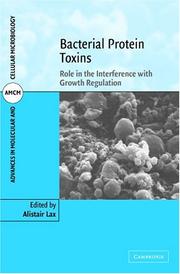
ISBN: 9780511546280 9780521820912 9780521177467 0511109687 9780511109683 0511109377 9780511109379 0511121180 9780511121180 0511546289 052182091X 1280162996 9781280162992 052182091X 1107136377 9786610162994 0511197225 0511298595 0521177464 Year: 2005 Publisher: Cambridge, UK ; New York, NY : Cambridge University Press,
Abstract | Keywords | Export | Availability | Bookmark
 Loading...
Loading...Choose an application
- Reference Manager
- EndNote
- RefWorks (Direct export to RefWorks)
Bacterial toxins that act inside cells interact very specifically with key components of the cell and some even manipulate the cell in subtle ways for their own purposes. These potent toxins, described in this 2005 book, will be of interest to both microbiologists and cell biologists. Some of these toxins are conventional multidomain toxins that are self-programmed to enter cells. Others are delivered by type III mechanisms, often as a package of potent molecules. The molecular targets for all these toxins mediate signal transduction and the cell cycle to regulate the crucial processes of cell growth, cell division and differentiation. Thus these potent toxins are not only responsible for disease, but also provide a powerful set of tools with which to interrogate the biology of the cell. In addition such toxins may act directly to promote carcinogenesis and hence their study is also of interest in a wider context.
Bacterial toxins. --- Bacterial antigens --- Microbial toxins
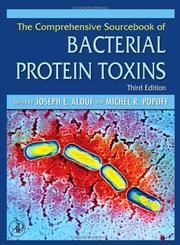
ISBN: 9780120884452 0120884453 0080456987 9780080456980 9786610628469 1280628464 Year: 2006 Publisher: Amsterdam ; Boston : Elsevier,
Abstract | Keywords | Export | Availability | Bookmark
 Loading...
Loading...Choose an application
- Reference Manager
- EndNote
- RefWorks (Direct export to RefWorks)
This book describes the major achievements and discoveries relevant to bacterial protein toxins since the turn of the new century illustrated by the discovery of more than fifty novel toxins (many of them identified through genome screening). The establishment of the three-dimensional crystal structure of more than 20 toxins during the same period offers deeper knowledge of structure-activity relationships and provides a framework to understand how toxins recognize receptors, penetrate membranes and interact with and modify intracellular substrates.* Edited by two of the most highly re
Bacterial toxins. --- Bacterial antigens --- Microbial toxins
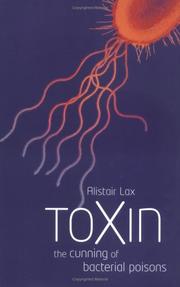
ISBN: 1280758147 0191513903 1429421568 9780191513909 9781429421560 9786610758142 661075814X 0198605587 9780198605584 0191578509 1383031223 Year: 2005 Publisher: Oxford New York Oxford University Press
Abstract | Keywords | Export | Availability | Bookmark
 Loading...
Loading...Choose an application
- Reference Manager
- EndNote
- RefWorks (Direct export to RefWorks)
Alistair Lax reveals the panoply of ways in which bacterial toxins overcome the defences in our cells. He explains how they work, how they are so successful in causing major diseases and how humans can learn to combat them, and even harness them for beneficial purposes.
Bacterial toxins --- Bacterial antigens --- Microbial toxins --- 579.61 --- 615.9 --- bacteriële toxines --- bacteriën --- biologie --- geneeskunde --- microbiologie --- pathologie --- toxicologie --- toxines --- medische microbiologie --- algemene toxicologie --- Bacterial toxins.
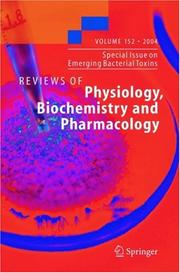
ISBN: 1281340936 9786611340933 3540271155 3540231315 Year: 2005 Publisher: Berlin, Heidelberg : Springer-Verlag Berlin Heidelberg,
Abstract | Keywords | Export | Availability | Bookmark
 Loading...
Loading...Choose an application
- Reference Manager
- EndNote
- RefWorks (Direct export to RefWorks)
(bitte wie üblich Contents nehmen).
Bacterial toxins. --- Biochemistry. --- Biological chemistry --- Chemical composition of organisms --- Organisms --- Physiological chemistry --- Biology --- Chemistry --- Medical sciences --- Bacterial antigens --- Microbial toxins --- Composition --- Medicine. --- Biomedicine general. --- Clinical sciences --- Medical profession --- Human biology --- Life sciences --- Pathology --- Physicians --- Health Workforce --- Biomedicine, general.
Book
ISBN: 9783319224558 3319224549 9783319224541 3319224557 Year: 2015 Publisher: Cham : Springer International Publishing : Imprint: Springer,
Abstract | Keywords | Export | Availability | Bookmark
 Loading...
Loading...Choose an application
- Reference Manager
- EndNote
- RefWorks (Direct export to RefWorks)
This book provides ample knowledge and better understanding of Streptococcus pyogenes and their superantigens. Many illustrations make this a highly informative book. This book elucidates briefly Streptococcus pyogenes as a strict human pathogen possessing an array of virulence factors. These help in evading host immune responses such as by the activation of non-specific T-cell subpopulations by producing superantigens. This book mainly focuses on streptococcal superantigens and explains how they are different from conventional antigens. Moreover, it elaborates those diseases in which superantigens are actively involved. Useful aspects of superantigens and different therapeutic interventions to eradicate superantigens induced diseased are also discussed.
Life Sciences. --- Microbiology. --- Life sciences. --- Sciences de la vie --- Microbiologie --- Streptococcus pyogenes. --- Superantigens. --- Biology --- Health & Biological Sciences --- Microbiology & Immunology --- Streptococcus hemolyticus --- Streptococcus --- Bacterial antigens --- Viral antigens --- Microbial biology --- Microorganisms
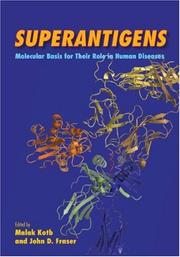
ISBN: 9781555814243 1555814247 9781555815844 1555815847 1283034131 9781283034135 9786613034137 6613034134 Year: 2007 Publisher: Washington : ASM Press,
Abstract | Keywords | Export | Availability | Bookmark
 Loading...
Loading...Choose an application
- Reference Manager
- EndNote
- RefWorks (Direct export to RefWorks)
A team of internationally respected researchers covers the basic molecular mechanisms of superantigen action, their structure and function, and their role in human diseases.
Superantigens. --- Superantigènes --- Immunologie --- Immunology --- Diagnostic de laboratoire --- Laboratory diagnosis --- Maladie de l'homme --- Human diseases --- Antigène --- Antigens --- Réaction antigène anticorps --- antigen antibody reactions --- Immunization --- Superantigènes --- Bacterial antigens --- Viral antigens
Book
ISBN: 1555818528 9781555818524 9781555816766 1555816762 Year: 2013 Publisher: Washington, DC
Abstract | Keywords | Export | Availability | Bookmark
 Loading...
Loading...Choose an application
- Reference Manager
- EndNote
- RefWorks (Direct export to RefWorks)
A comprehensive compendium of scholarly contributions relating to bacterial virulence gene regulation.
Bacteria --- Bacterial genetics. --- Bacterial toxins. --- Bacteriophages --- Virulence (Microbiology) --- Virulence factors --- Microbial virulence --- Pathogenic microorganisms --- Bacteriophage --- Phages --- Viruses --- Lysogeny --- Transduction --- Bacterial antigens --- Microbial toxins --- Bacteriology --- Microbial genetics --- Germs --- Microbes --- Prokaryotes --- Pathogenicity. --- Physiology. --- Genetics
Book
ISBN: 3319676512 3319676504 Year: 2018 Publisher: Cham : Springer International Publishing : Imprint: Springer,
Abstract | Keywords | Export | Availability | Bookmark
 Loading...
Loading...Choose an application
- Reference Manager
- EndNote
- RefWorks (Direct export to RefWorks)
Bacterial Pathogens and their Virulence Factors contains a detailed description of 32 major bacterial pathogens that affect human health and their associated virulence determinants. Chapter 1 gives an overview of the different types and classes of general virulence factors involved in host cell adherence and invasion, dissemination within the host, host cell damage, and evasion of host defense systems, as well as mechanisms by which these virulence factors are regulated. Chapters 2 through 33 give concise descriptions of the disease states associated with the 32 bacterial genera and their major pathogenic species, along with an in-depth description of the individual virulence factors that have been found to be functionally involved in pathogenicity. A detailed bibliography derived from primary literature and review articles accompanies each of these chapters, allowing the reader to delve more deeply into individual pathogens and their virulence determinants.Chapter 34 discusses the exciting possibilities and initial successes of using detailed information on a pathogen’s virulence toolkit to design new therapeutics aimed at specific virulence traits.
Medicine. --- Medical microbiology. --- Infectious diseases. --- Bacteriology. --- Medicine & Public Health. --- Infectious Diseases. --- Medical Microbiology. --- Bacteria. --- Bacterial toxins. --- Bacterial antigens --- Microbial toxins --- Germs --- Microbes --- Prokaryotes --- Emerging infectious diseases. --- Microbiology. --- Microbiology --- Emerging infections --- New infectious diseases --- Re-emerging infectious diseases --- Reemerging infectious diseases --- Communicable diseases --- Microbial biology --- Biology --- Microorganisms
Book
ISBN: 3319588931 3319588915 Year: 2017 Publisher: Cham : Springer International Publishing : Imprint: Springer,
Abstract | Keywords | Export | Availability | Bookmark
 Loading...
Loading...Choose an application
- Reference Manager
- EndNote
- RefWorks (Direct export to RefWorks)
This volume focuses on the transport of medically relevant bacterial protein toxins into mammalian cells, and on novel pharmacological strategies to inhibit toxin uptake. The first chapters review our current understanding of the cell-surface receptors and cellular transport processes of Clostridium botulinum neurotoxins, Clostridium botulinum C3 toxin, Clostridium difficile toxins, binary clostridial enterotoxins, anthrax toxins and diphtheria toxin. In brief, specific binding/transport (B) subunits deliver the enzyme (A) subunits into the cytosol, where the latter modify their substrates, producing cytotoxic effects and the characteristic toxin-associated diseases. Key mechanisms for the transport of the A subunits from endosomes into the cytosol and the role of trans-membrane pores formed by the B subunits and host cell chaperones for this process are reviewed. The book’s closing chapters focus on compounds which inhibit the transport of the A subunits from endosomes into the cytosol and therefore might lead to novel therapeutic strategies for toxin-associated diseases. These substances include pharmacological inhibitors of the host cell chaperones involved, as well as multivalent and heterocyclic molecules that specifically block the toxins’ translocation channels. This volume offers an up-to-date resource for scientists.
Medicine. --- Medical microbiology. --- Pharmacology. --- Infectious diseases. --- Biomedicine. --- Medical Microbiology. --- Pharmacology/Toxicology. --- Infectious Diseases. --- Drug effects --- Medical pharmacology --- Medical sciences --- Chemicals --- Chemotherapy --- Drugs --- Pharmacy --- Clinical sciences --- Medical profession --- Human biology --- Life sciences --- Pathology --- Physicians --- Physiological effect --- Bacterial toxins. --- Bacterial antigens --- Microbial toxins --- Microbiology. --- Toxicology. --- Emerging infectious diseases. --- Emerging infections --- New infectious diseases --- Re-emerging infectious diseases --- Reemerging infectious diseases --- Communicable diseases --- Medicine --- Pharmacology --- Poisoning --- Poisons --- Microbial biology --- Biology --- Microorganisms --- Toxicology
| Listing 1 - 9 of 9 |
Sort by
|

 Search
Search Feedback
Feedback About UniCat
About UniCat  Help
Help News
News